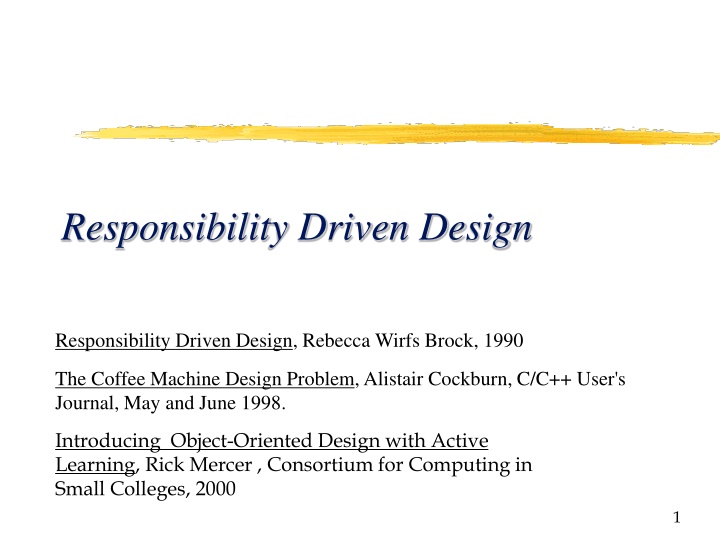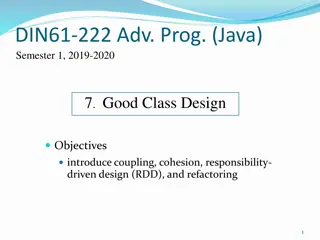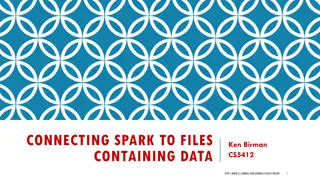
Responsibility-Driven Design Principles and Object-Oriented Design
Explore Responsibility-Driven Design principles focusing on behavioral modeling and collaboration among objects. Learn about the Single Responsibility Principle and how to design models with a clear focus on object responsibilities.
Download Presentation

Please find below an Image/Link to download the presentation.
The content on the website is provided AS IS for your information and personal use only. It may not be sold, licensed, or shared on other websites without obtaining consent from the author. If you encounter any issues during the download, it is possible that the publisher has removed the file from their server.
You are allowed to download the files provided on this website for personal or commercial use, subject to the condition that they are used lawfully. All files are the property of their respective owners.
The content on the website is provided AS IS for your information and personal use only. It may not be sold, licensed, or shared on other websites without obtaining consent from the author.
E N D
Presentation Transcript
Responsibility Driven Design Responsibility Driven Design, Rebecca Wirfs Brock, 1990 The Coffee Machine Design Problem, Alistair Cockburn, C/C++ User's Journal, May and June 1998. Introducing Object-Oriented Design with Active Learning, Rick Mercer , Consortium for Computing in Small Colleges, 2000 1
In Rebecca Wirfs Brocks' Words Responsibility-Driven Design is a way to design that emphasizes behavioral modeling using objects, responsibilities and collaborations. In a responsibility-based model, objects play specific roles and occupy well-known positions in the application architecture. Each object is accountable for a specific portion of the work. They collaborate in clearly defined ways, contracting with each other to fulfill the larger goals of the application. By creating a "community of objects", assigning specific responsibilities to each, you build a collaborative model of our application. Responsible: able to answer for one's conduct and obligations trustworthy, Merriam Webster 2
Responsibility Driven Design in Rick's words 1. Identify candidate objects that model a system as a sensible set of abstractions 2. Determine the responsibility of each object what an instance of the class must be able to do, and what each instance must know about itself 3. Understand the system through role play To help complete its responsibility, an object often needs help from other objects 3
OO Design Principle The Single Responsibility Principle Classes should have a single responsibility http://en.wikipedia.org/wiki/Single_responsibility_principle Why? Cohesion, when high, reduces complexity, makes the system more understandable http://en.wikipedia.org/wiki/Cohesion_%28computer_science%29 Maintenance: Fixing or changing a module should not break other parts of the system 4
First Design a Model Note: design is iterative Find a set of objects (candidate classes) that model a solution Each will be a part of the bigger system Each should have a single responsibility What are these objects? 5
Find the Objects Candidate objects may come from An understanding of the problem domain knowledge of the system that the problem specification may have missed or took for granted The words floating around the room Alistair Cockburn The nouns in the problem statement Underline the noun phrases to look for the objects that could model the system 6
The Problem Specification repeated The student affairs office want to put some newfound activity fee funds toward a Jukebox in the student center. The Jukebox must allow students to play a song. No money will be required. Instead, a student will swipe a magnetic ID card through a card reader, view the song collection and choose a song. Students will each be allowed to play up to 1500 minutes worth of "free" Jukebox music in their academic careers, but never more than two songs on any given date. No song can be played more than five times a day*. *What a drag it would be to hear "Dancing Queen" 14 times while eating lunch (apologies to ABBA) 7
A First Cut at the Candidate Objects (may become classes) What objects effectively model the system? What is the responsibility, Example Song: Know song title, artist, playtime, how often it's been played today Others? 8
Yesses Jukebox: coordinates activities one instance to start things and keep them going JukeboxAccountchanged from Student: maintain one account: model user who play songs Song: one song that can be played CardReader: reads the magnetic ID card 9
A No StudentIdCard: store user data Object-Oriented Design Guideline Eliminate classes that are outside the system The hallmark of such a class is one whose only importance to the system is the data contained in it. Student identification number is of great importance The system should not care whether the ID number was read from a swiped magnetic ID card, typed in at the keyboard, or "if a squirrel arrived carrying it in his mouth" ArthurReil 10
More Candidate Objects? SongCollection: songs to choose from What about storing a collection of accounts? JukeBoxAccountCollection Use a compact disk player or real Jukebox? Could have a software equivalent like SongPlayer to play audio files? 11
Date Date: Can determine when a song is played and the current date. Maybe Can we use use java.util.GregorianCalendar? 12
Another No? StereoSystem: Amplifies the music No, it's on the other side what we have to build The next slide summarizes some needed candidate objects It also sets the boundaries of the system There are model of the real world objects 13
Candidate Objects and the system boundary Rick drew this before UML existed CardReader Gets student ID JukeboxAccountCollection Stores all JukeboxAccount objects JukeboxAccount JukeBox Coordinates activities SongCollection Stores all Songs that can be played Song SongPlayer Plays a song 14
Another Example http://www.ifi.uio.no/in219/verktoy/doc/html/doc/user/mg/dgmsuml6.html Scenario: The user tries to use an ATM, but the account is not known 15 30
Role Play Need 7 students to play the role play the scenario Rick wants to play Feelin Alright 1. CarderReader 2. JukeboxAccountCollection 3. JukeBoxAccount 4. Jukebox 5. Songplayer 6. SongCollection 7. Song The rest of you will have to write a sequence Diagram by hand, it will be like taking notes, a start 16









